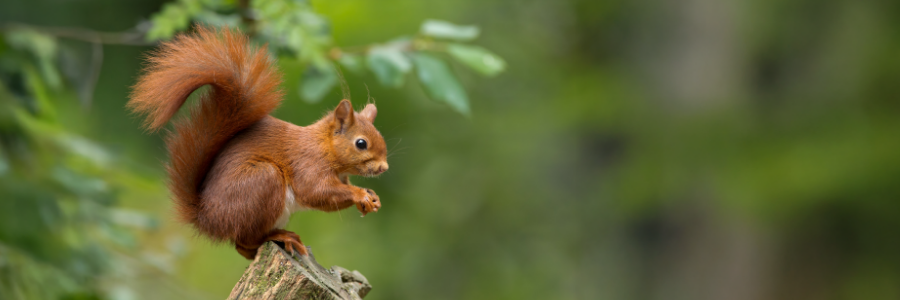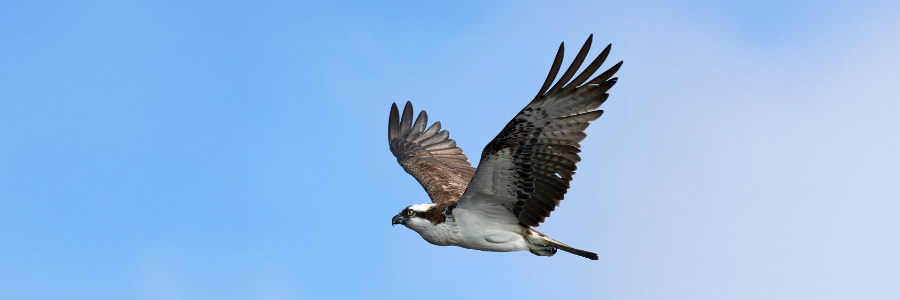The least inhabited and most peaceful National Park in England, Northumberland is a natural haven for wildlife.
In this quiet corner of the country, native species flourish – offering a unique opportunity for botanists, birdwatchers and animal-lovers to experience local wildlife in their natural habitats.
And, from elusive red squirrels and majestic osprey to beloved puffins and the rare Cheviot goat – in Northumberland, there’s something to see all year round.
Set at the doorstep to the National Park, our 300-acre estate is home to native hawks and deer. It also provides the perfect base to get out into the forests, fields and shores of our region and meet Northumberland’s native wildlife during your stay.
Woodland
Eurasian Red Squirrel
Where: Kielder
Best time to visit: Spring and Autumn
Kielder Forest is a world of natural enchantment. Europe’s largest man-made forest, it’s become home to diverse wildlife – including England’s largest population of endangered red squirrels.
Follow mile upon mile of woodland trails, sheltered by spruce and native Scots pine to breathe in the hush and peace of the woodland. The forest is a natural habitat for 50% of the country’s red squirrels, with several opportunities throughout the year to see them.
Keep an eye on the forest floor in spring when the the squirrels emerge from hibernation and can be seen out and about, foraging for food. Again, in autumn they become more active, seeking and storing food for winter.

English Pine Marten
Where: Wallington Hall
Best Time To Visit: June to August
Elusive and characterful, pine martens were once a familiar sight in England’s forests. Now the second most rare carnivore in Britain, they are being reintroduced, with conservation projects working to bring native pine martens back to British woodland.
Our northern border region is a strategic recovery area, with a new English Pine Marten Haven site installed at Northumberland’s Wallington Hall this summer. Den boxes have been installed in the forests surrounding the state alongside a wildlife hide.
A fantastic day out in its own right, take trip to the National Trust property to step into the wildlife hide to explore the woodlands and learn more about the project.
Western Osprey
Where: Kielder
Best Time To Visit: April to August
Kielder is also home to nesting western ospreys, a rare and protected bird of prey. Majestic and endangered, these beautiful birds became extinct in England in the 1800s. Happily, after conversation efforts their numbers are growing and in Kielder, ospreys return each spring to roost in remote areas of the forest.
On weekends from April to August, Osprey Watch activities take place, inviting visitors to spot the birds using high powered telescopes. Fish-eating birds of prey, Kielder’s ospreys are most active by the water’s edge. Take an Osprey Watching Cruise out onto Kielder Water to get close to these impressive birds.

Coastal
Atlantic Puffin
Where: Farne Islands
Best Time To Visit: April – June
Beloved worldwide, puffins have become a symbol of the wild Northumbrian coast. A National Nature Reserve, the Farne Islands are home to 43,000 pairs of puffins, offering a unique opportunity to see these sweet and whimsical birds in person.
Head for the coast and take a boat trip to the Farne Islands. The island is open to visitors from April to September, with puffins returning to the islands in mid-April. Your best chance to see puffins is between May and June, when they are actively nesting and feeding their chicks.
Atlantic Grey Seal
Where: Lindisfarne
Best Time To Visit: March – October
Cheeky and full of personality, seals are a familiar sight up and down the coastline here in Northumberland.
But for a truly unique experience, take a walk to the island of Lindisfarne. Also known as Holy Island, this ancient and peaceful place is a tidal island, regularly cut off by the north sea. Follow the Pilgrim’s Way to walk there from the mainland, following the sandy causeway to spot seals basking on the sandbanks and listen to their haunting song.
Be careful to check tide times to stay safe and avoid being cut off, and for a guided experience, try Footsteps Northumberland.

Hills & Moorland
Cheviot Goats
Where: The Cheviot Hills
When: All year round
Ancient and wild, Cheviot goats are thought to be an authentic remnant of Britain’s original primitive goats, pre-dating modern goat breeds. Local legend has it that when the monks of Lindisfarne abandoned their monastery in 875AD, they found the goats to feisty to herd – and they were left to roam the Northumbrian landscape.
They still live freely today, making their home in the rolling Cheviot Hills. Added to the Rare Breeds Survival Trust watchlist in 2024, wild Cheviot goats live in small family groups and are active all year round.
With a range of walking routes, from relaxing strolls to a challenging hike to the top of Cheviot itself – lace up your boots for a day in the wild to spot these unique Northumbrian animals.
Nestled in the heart of Northumberland, our estate is within easy reach of the forests, hills and shores of our region. So, wherever your wild adventure takes you, return to relax in luxury at Northumberland’s only 5 star hotel.


